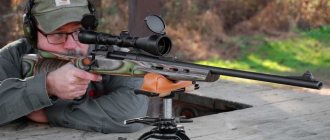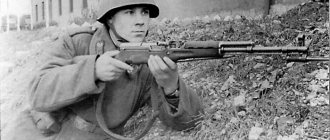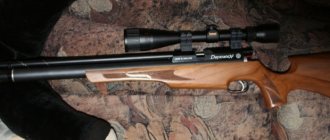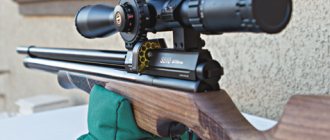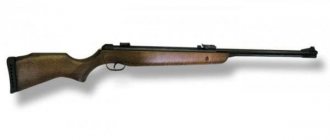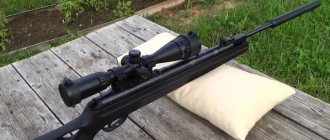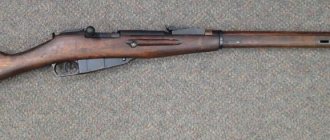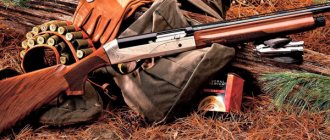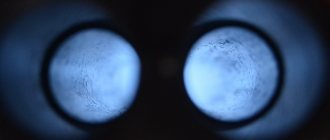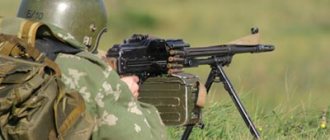Turkish air rifles are very popular among Russian hunters due to their outstanding technical characteristics, as well as ease of maintenance. However, this does not mean that the weapon does not require regular cleaning and lubrication. We’ll talk about how to carry out such procedures correctly, as well as which gun oil is best to choose, in this article.
Basic cleaning rules
The gun manufacturer provides recommendations on the frequency of cleaning and lubrication. The owner can determine the time when it is time to put his rifle in order. Regardless of the model brand, you need to adhere to certain rules. You can strip the lead completely off before storing the weapon for a long time.
Debris inside the rifled barrel must be removed with care to avoid damaging it. Rinse only with recommended products using devices and tools designed for this purpose.
Cleaning process
The new gun contains lubricant on all metal parts that rub against each other. The barrel is also lubricated, and until a certain number of shots are fired, there is no lead. Excess barrel lubrication in a new gun must be removed, otherwise it will ignite and the release of gases from combustion will harm the mechanism. In the future, the rifle is cleaned without waiting for the moment when the bullets begin to constantly fly away.
For the cuff and piston, it is better to use silicone lubricant. Lubricate the piston and cuff with a thin layer - only along the edges. Under no circumstances should lubricant enter the compressor.
If it is possible to completely remove the barrel, then this should be done. On the muzzle side, plug the hole with a patch or a piece of rags, and pour cleaning agent inside. You need to pour or spray more of it, let it stand, turning the gun so that wetting occurs evenly.
The brass brush screwed onto the cleaning rod must be pushed from the breech to the muzzle, unscrewed, and the cleaning rod removed. In case of heavy contamination, you need to repeat the steps 4-5 times. That is, the brass (bronze) brush cannot be pulled back, so as not to spoil the cutting.
Before using a nylon or nylon brush, you need to check that the cleaning agent does not dissolve its lint. A soft brush will pick up any remaining lead and lint from the brass brush.
After this, cleaning is continued with patches or pieces of cotton pad. The visher with the patch should also be run from the breech to the end until a clean patch without glitter or dirt appears at the output.
Lubricate the gun with the same ballistone. A patch or cotton pad placed on the visher is lightly moistened with balliston and pushed through. Use a powder puff to rub the lubricant over the barrel. A weapon that is completely free of traces of lead will hit less accurately for some time, until a layer of lead accumulates on the walls of the barrel.
The procedure is completed by pushing a patch, which will remove excess oil.
Using a clean rag, you should thoroughly wipe the barrel on all sides, especially in the area adjacent to the breech.
Basic rules for lubrication of an air gun
How to lubricate an air gun, with what frequency and means, in what places to apply - information is indicated in the product operating instructions.
The procedure is necessary both during and after cleaning the weapon. In the first case, to reduce the contact of the maintenance tool with the surface of weapon parts, to remove lead or carbon deposits. In the latter case, lubrication of the weapon prevents corrosion and severe contamination. You need to apply the product correctly, otherwise the result will be the opposite.
The barrel is lubricated first, then the parts of the reproduction system: the air cylinder, seals, cuff, etc. The product must be applied gradually in places where the system parts come into contact to avoid oil bubbles during shooting.
The “diesel effect” also has a negative effect on weapons. The owner of the PPP needs to first apply a little product (2 drops are enough), then fire 3 shots using light projectiles or a felt wad - practical experience is used when selecting the size and degree of density.
There are products on sale that prevent the formation of the “diesel effect”. To ensure that the oil is evenly distributed over the walls of the air cylinder, the user fires up to 10-20 shots, after which the power of the air pistol will be stable. You can purchase a product with a thick consistency designed for treating springs - the coils hit each other less easily.
On gas-cylinder models of pistols, it is worth lubricating the seals of the dosing system after consuming 1-3 cans, no more. The rule applies to air-inflated cartridges. Check the seals - each air cartridge is lowered into a container of water.
Treatment of the USM (trigger mechanism) is carried out after shooting 1500 - 2000 bullets, if the operating instructions for the pistol do not contain appropriate recommendations. The main thing is not to overdo it so that the lubricant does not become a “collection” of dirt and dust. At the end of the procedure, you need to check the operation of the trigger, fuse and other mechanisms.
It is advisable to apply oil to the weapon's cocking system, tightening screw, and magazine release mechanism. The final stage - the treated surface is wiped dry with a cotton material previously moistened with a neutral composition. Then a new thin layer is applied. You should protect the stock, especially wood, from contact with lubricants in advance. If this happens, you should immediately and thoroughly wipe the surface.
Washing bullets
Caring for your gun includes washing the bullets. Domestic bullets need to be washed especially carefully. Soft lead always remains in the cutting grooves, and over time it can clog them completely.
Place a pack of bullets in a container and fill it with kerosene or diesel fuel, leave for a while, stirring. The fuel needs to be drained. You can place the bullets in a gauze bag or fine sieve and degrease the kerosene with dishwashing detergent, acetone or alcohol. Blow-dried bullets can be used for shooting. Lead will also get stuck in the rifling of the barrel, but there will be noticeably less dirt.
Do I need to wash the bullets?
The service life also depends on the cleanliness of the bullets. The washing procedure is relevant for Russian-made shells, which are loved by most air gun owners for their affordability.
The bullet washing process consists of the following steps:
- Lead bullets are poured into a separate container. Next, fill in diesel fuel or kerosene, which will remove foreign particles and galvanizing from the shells.
- Drain the flammable substance and empty all the bullets from the container - dry well. It is allowed to reuse kerosene or diesel fuel, but only 3 times.
- Dried ammunition is placed in a clean glass or other container and filled with soapy water. You can replace it with any dishwashing detergent - this option is better, because it effectively removes traces of petroleum products, and the bullets will be flawless.
- A hair dryer will help speed up the drying process of bullets. But before shooting, you need to make sure that the bullets are thoroughly dry, otherwise plaque will form in the barrel bore.
The advantage of clean bullets is that they do not stick to your fingers, and there is no oil film (a characteristic feature of all lead analogues). After shooting the “air”: there is almost no soot, good accuracy of fire from long distances (the deviation of the projectile along the flight path is minimal or absent).
Features of cleaning different models
There are 5 types of air guns, and each type has its own cleaning features and maintenance features.
A spring-piston air rifle (SPR) is the easiest to use, but you need to ensure the integrity of the piston seal.
An air rifle with pre-pumping, compression and multi-compression rifles, as well as carbon dioxide pneumatics, have a different system for obtaining pressure in the barrel to push the bullet out.
A multi-compression rifle (MK) with underinflated pressure and the lowest bullet speed becomes clogged with dirt faster than more powerful pumped-up rifles.
During operation, carbon dioxide and compression cans move a greater air flow and become less dirty, but condensation occurs due to temperature changes. Rust appears in the breech of the barrel, and if measures are not taken in time, it will spread along its entire length.
Regular inspection, cleaning and lubrication will long extend the life and technical characteristics of the rifle.
Step-by-step cleaning of a rifle barrel
The cleaning process is as follows:
- removal of lead residues;
- degreasing;
- drying;
- oil lubrication.
It will take a lot of effort to remove lead plaque. An adult man can do it without any problems - naturally, a bronze brush is used. Only this non-ferrous metal is capable of removing lead without significantly damaging the channel. Using Ballistol the user washes away lead residue and reduces friction.
If a spring-piston “air” with a side or under-barrel cocking lever is being cleaned, you should look at the bypass to see if oil drops, lead or bronze shavings can get into the hole. Otherwise, when making the first shot, you will most likely need to clean it again.
Degreasing the barrel is the next step after removing lead deposits. Here the user removes dirty oil - with impurities of bronze and lead. Degreasing with gasoline or other flammable substances is unacceptable. Acetone can be used. The result is that there are no flammable vapors in the barrel.
The bypass hole is closed before the degreasing procedure. It is better to use a nylon brush for the procedure. You need to be careful when choosing a tool - it must be resistant to acetone, otherwise the channel will be covered with a polymer layer.
You can skip the degreasing step, but use drying. It is enough to use pieces of dry cotton fabric or cotton pads. It is better to dry with a visher - a special ramrod attachment. The addition is bronze, with a screw groove. A thin strip of the selected material is inserted into the latter. Drying is completed when no oil or other traces remain.
The last stage is to lubricate the barrel with a thin layer. This will allow the pellet to move easily through the channel. For rifles, the main thing is to choose the correct proportion and thickness of the oil - it is allowed only in liquid form. If Ballistol is not applied in a thin layer, the rifle's accuracy will suffer.
Self-blue barrel
Even if the shooter decides to bluing the entire weapon, the barrel must be separated from the gun. Cold, hot or oxidation bluing begins with cleaning the previous layer. The wood and composite parts are removed from the gun.
First you need to sand all the parts that are intended to be blued, polish and degrease with acetone. Cold bluing involves brushing all metal parts with a special compound that is sold in gun stores. The quality will depend on the correct position of the gun and its parts for drying, and on the ability to work with a brush.
Hot is a method when a barrel heated over a fire is dipped into cold linseed, machine, or gun oil for a few seconds. The composition of the oil does not matter, as long as it is clean. You don't need to hold it for more than 10 seconds.
Afterwards, the thickly coated barrel is heated on all sides with a blowtorch. The oil boils directly on the heated area and is absorbed into the metal. Readiness is determined by eye, by color.
It is not advisable to carry out the acid blackening method without an experienced assistant. Diluting the solution for work, maintaining the exact dosage (up to a gram) is not the most important condition. It is important not to get poisoned, burn the respiratory tract or skin while working.
How to lubricate an air rifle
Finally, we have come to an analysis of the main question of the article, which will tell you which composition is best to use for lubricating the Hatsan air rifle. Especially for this, we studied information from various gun stores and forums about which oil is most popular among Turkish gun owners. We place the result in a small TOP with a brief description of each oil model:
- Balistol gun oil in spray form. A very popular and versatile gun oil, which comes in the form of a spray, which greatly facilitates the lubrication process. For a bottle with a capacity of 50 milliliters you will have to pay only 230 rubles, which is very cheap, especially for such high-quality products. In addition, this oil can be found in any gun store, as it is in great demand.
- Gun oil SBH. High-quality Russian oil, which is suitable for lubricating both smooth-bore and rifled weapons. It owes its popularity to its low price - only 210 rubles for 50 milliliters, as well as its availability - it is sold almost everywhere. Available in a plastic bottle or spray form. Can be used to lubricate the barrel or small parts of a rifle.
- Brunox Gun. Very economical and quite good oil from a German manufacturer. Supplied in the form of a plastic jar with a round lid, volume 100 milliliters and costing 350 rubles. It is manufactured in accordance with international quality standards, so a rifle lubricated with this oil can be safely used in almost any weather conditions.
- Balistol Silicon. Another product from the mentioned company, which is very useful for lubricating small parts of weapons (trigger mechanism, Blowback, bolt frame, and so on). It lasts quite a long time, so there is no need for regular maintenance of the rifle. It comes in the form of a 65 milliliter spray and costs around 280 rubles.
- Brunox Lub&Cor. Not only oil, but also a special chemical composition that protects the barrel from corrosion. The cost of a 100-milliliter bottle is 420 rubles, but most owners of the Hatsan rifle claim that it is worth it. The composition not only prevents the appearance of corrosion, but also fights well against already formed rust. Suitable for indoor and outdoor maintenance.
And these are just the 5 best oils that are well suited for lubricating Hatsan air rifles.
It cannot be said that formulations from other manufacturers are much worse than these, however, the above-mentioned models not only have high quality, but also have a positive effect on the ballistic characteristics of Turkish rifles.
Cleaning accessories
To clean your rifle, you need to buy a cleaning kit that includes:
- ramrod;
- Visher;
- pipe cleaners;
- patches;
- clean rags.
A cleaning rod made of wood, bronze or other metal should rotate easily in the bearing. A one-piece or composite cleaning rod must be durable. Experienced users do not recommend a composite cleaning rod, because if the cleaning rod breaks, the barrel can be seriously damaged by the metal parts of the joints.
Visher comes with a loop for patches made of brass or with a winding for rags. Hard brushes made of bronze, copper or brass wires, softer nylon and very soft puffs are consumables.
Patches made of pure cotton fabric or felt are taken according to the size of the barrel caliber, but can be replaced with cotton pads and swabs. You will need containers and containers for diluting the solution, cleaning agents and lubricants.
There should be a first aid kit and clean water in the room in case of a chemical or thermal burn. A strong fishing line, folded in half, can replace a cleaning rod. In some brands of rifles, it is impossible to insert a rigid cleaning rod into the barrel from the breech, then a fishing line or cord will eliminate the need to remove the barrel for cleaning.
What funds will be required
The best solution would be to purchase a ready-made set of tools for cleaning rifles and pistols. It usually consists of a bronze brush and a cleaning rod. Additionally, other materials may be needed:
- A nylon brush is effective for cleaning rifled and smooth trunks. And it costs less on the market than its bronze counterpart. The only downside is a large number of shavings after using it.
- Cotton fabric must be thin, clean and dry. Special materials are sold on the shelves of weapons stores - they can also be used. If this is not possible, you can tear up an old T-shirt.
- Acetone liquid is a worthy replacement for the alkaline composition. It dries instantly, but the chemical composition is more economical in price.
Of course, the best weapon lubricant is Ballistol. Suitable for all types of air guns. Budget or professional device – it doesn’t matter. The oil is sold in aerosol form.
Proper storage
An air gun is not as dangerous as a traumatic weapon, but it must be kept in a place inaccessible to strangers and unloaded. If you don't have an iron safe, a strong cabinet with a lock will do. Only an adult gun owner should have the key to the cabinet.
The rifle, dry, free of dust and excess grease, is unloaded and the safety is put on. A thick cotton or canvas hunting case is suitable for transportation.
Folded shotguns take up less space, but the spring in the PPP either weakens or becomes bent due to long cocking.
